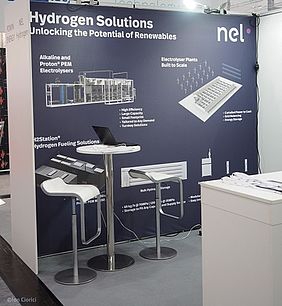Scientists have been searching for years to find materials which do not need precious metals to produce active and stable reactions in order to discover alternatives to fossil fuel in energy production. The oxygen evolution reaction (OER) is a vital part of many of these reactions where water is split in electrolysers to produce hydrogen that can power fuel cells.
Now (2020), scientists at the U.S. Department of Energy’s (DOE) Argonne National Laboratory have employed a combination of high-precision materials, science and electrochemistry, and provided important insights into what mechanisms were responsible for the stability and activity of materials during the OER. In the future these insights could influence the make-up of materials for the production of electrochemical fuel.
The scientists analysed an electrolyser material, called a hydr(oxy)oxide, and discovered that although electrolysers could behave as if they were wholly stable, on an atomic scale the systems were extremely dynamic. They discovered that the iron atoms in the electrode repeatedly detached and reconnected to the interface or the surface responsible for the oxygen-producing reactions. This careful balance allowed for the overall stability of the material.
The scientists designed highly-sensitive electrochemical measurement tools to monitor the iron activity in situ during the OER and to test the system with various levels of impurities and to find out what impact they might have on the overall stability of the material. The scientists found that the behaviour of the iron at the interface influenced how well the material could produce oxygen in the OER process.
Scientists have long sought to improve hydrogen production through employing more efficient electrolytic components. In 2016, scientists discovered a method that enabled manufacturing an electrode material for electrolytic hydrogen generation. Tungsten salt and nickel salt were combined in a determined molar ratio on a carbon support by successfully controlling synthesis temperature and composition. Water and adsorbed oxygen that were produced by mixing the tungsten salt and nickel salt were removed. Then, methane gas was flowed over the mixture resulting in the electrode material. The resulting electrode material could be used as a catalyst in electrolytic hydrogen generation processes, for example, on an industrial scale, to produce large quantities of hydrogen.
In 2020, scientists used an oxide of perovskite to create an oxygen electrode for use in electrochemical cells used for hydrolysis-based hydrogen production. They developed triple conducting oxide of PrNi0.5Co0.5O3-δ perovskite as an oxygen electrode, which presented superior electrochemical performance at 400~600 °C. More importantly, the self-sustainable and reversible operation was demonstrated by converting the generated hydrogen in electrolysis mode to electricity without any hydrogen addition. The material exhibited excellent electrocatalytic activity which could be ascribed to the considerable proton conduction, remarkable hydration behaviour and computations.
In the future these new insights into electrolytic material may significantly enhance the hydrogen production process. Once scientists can determine the role of iron and how its movements impact the oxygen evolution process, they will be able to modify materials to take advantage of dynamic stability, ensuring that there is enough iron present at the interface to boost oxygen production. Scientists are convinced that “the profound implications of the decoupling of virtual stability and true stability will extend the design rules for producing active and stable interfaces”.
The dynamic stability in hydr(oxy)oxide, which is responsible for stable behaviour at the macroscopic level despite high activity at the atomic level, is a very important quality for electrolysers. The scientists hope to be able to make good use of their new understanding of this phenomenon to design materials with better performance.
